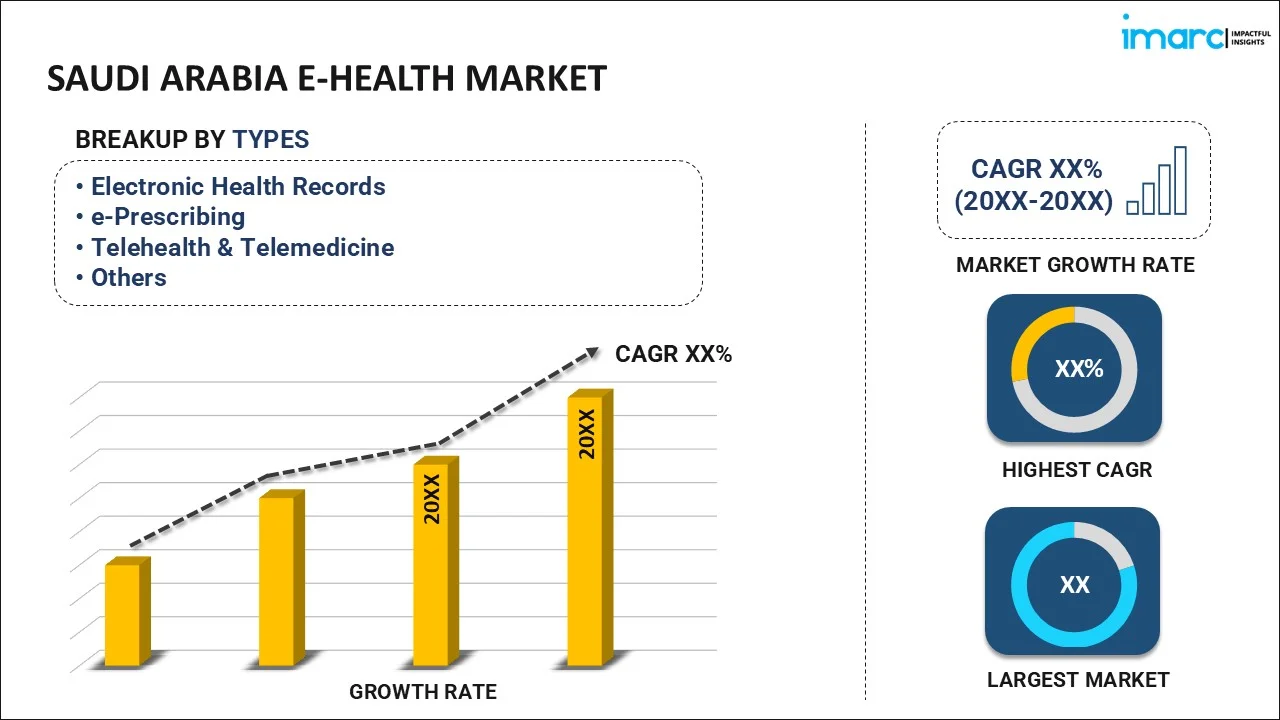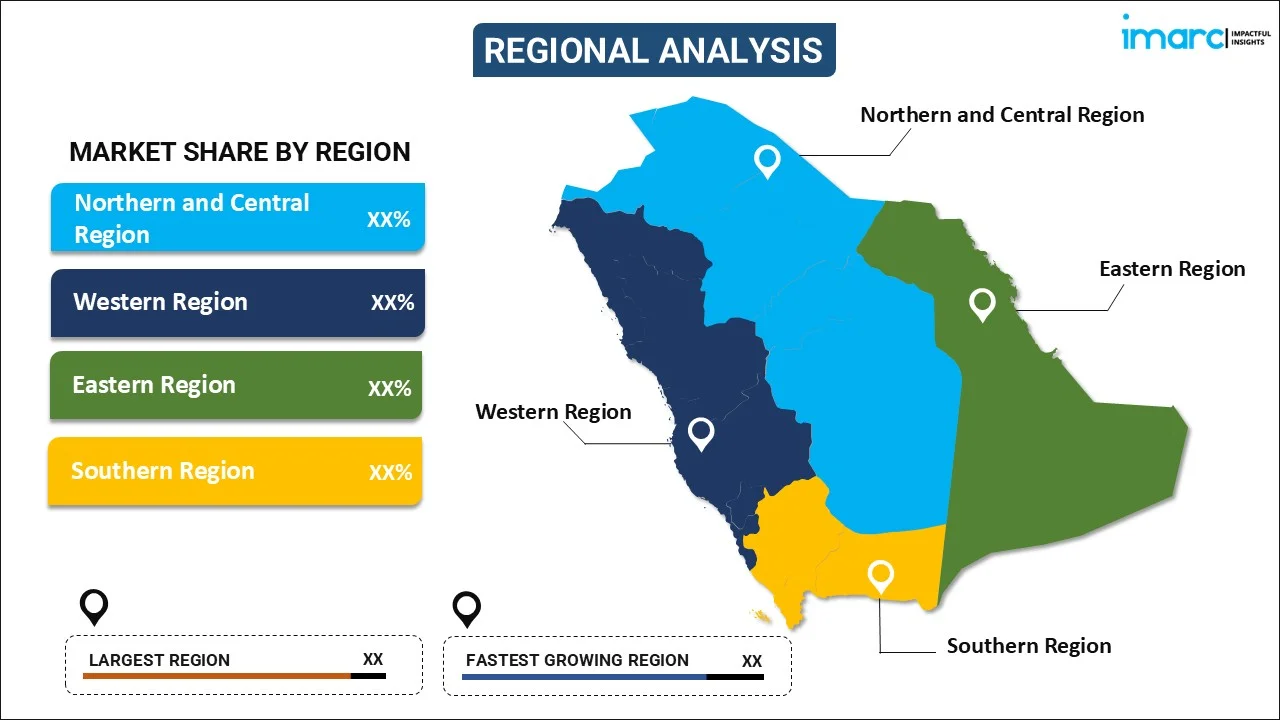
Saudi Arabia E-Health Market Size, Share, Trends and Forecast by Type, Services, End-User and Region, 2025-2033
Saudi Arabia E-Health Market Overview:
The Saudi Arabia e-health market size reached USD 1.31 Billion in 2024. Looking forward, IMARC Group expects the market to reach USD 5.03 Billion by 2033, exhibiting a growth rate (CAGR) of 16.13% during 2025-2033. Positive government policies for digital health revolution, higher investments in healthcare, mounting demand for distant healthcare services, expanding internet coverage, and uptake of sophisticated technologies such as AI, telemedicine, and electronic health records (EHRs) are among the major determinants bolstering the market growth.
|
Report Attribute
|
Key Statistics
|
|---|---|
|
Base Year
|
2024 |
|
Forecast Years
|
2025-2033
|
|
Historical Years
|
2019-2024
|
| Market Size in 2024 | USD 1.31 Billion |
| Market Forecast in 2033 | USD 5.03 Billion |
| Market Growth Rate (2025-2033) | 16.13% |
Saudi Arabia E-Health Market Trends:
Vision 2030 and government initiatives
Saudi Arabia's Vision 2030 strategy is a foundation for diversifying and modernizing its economy, resulting in massive investment in digital transformation, especially in the healthcare industry. The strategic plan is aimed at improving healthcare access and quality using digital solutions, thereby driving the growth of the e-health market. Vision 2030 places emphasis on enhanced healthcare infrastructure, resulting in the adoption of EHRs, mobile health apps, and telemedicine platforms. The "e-Health Strategy" of the Ministry of Health is in line with such objectives, facilitating electronic integration in clinics and hospitals, automating patient information handling, and enhancing inter-institutional sharing of health data. The interest of the government in making healthcare accessible to all citizens has also spurred on the development of e-health services in remote and underserved regions, where healthcare services are made accessible to a larger population through electronic means, thus strengthening the market growth.
Advanced technology adoption
The implementation of cutting-edge technologies such as AI, the Internet of Things (IoT), and big data analytics is transforming healthcare in Saudi Arabia. AI-powered diagnostic equipment, predictive analytics, and machine learning algorithms are being used more and more to examine medical data, forecast patient outcomes, and tailor treatment plans. Wearable devices based on IoT, for example, remote monitoring systems and fitness trackers, facilitate real-time monitoring of vital health parameters, allowing doctors access to ongoing patient health information and lowering hospital consultations. Big data analytics is also revolutionizing medical research by enabling insights into the patterns of disease, treatment efficiency, and optimizing resources. Thus, the increasing adoption of these technologies to enhance the quality of patient care and empower healthcare providers to save costs and streamline operations, which are essential for large-scale digital health implementations, is facilitating market growth.
Rising demand for telemedicine and remote healthcare services
Saudi Arabia's increasing demand for remote healthcare and telemedicine services is a major driver of the market growth. Due to the attempts to reduce the number of visits to hospitals, telehealth technologies became necessary and led to increased demand for online consultations and diagnostic equipment. As per the Dovepress, a Francis and Taylor Group, the 937-Call Center in Saudi Arabia is a prime example of the country's dedication to improving telehealth access to healthcare. The center, which is open around-the-clock and offers services like emergency triage and medical consultations, is especially helpful to people who cannot use the internet or physically visit medical facilities. This program addresses the particular difficulties that the Saudi populace faces while also being in line with international telehealth initiatives. Telemedicine platforms help patients gain simple access to health professionals, facilitate timely medical opinion, and decrease travel time as well as travel expenses. Remote healthcare services, including digital patient portals and virtual consultations, enable ongoing care management, especially for chronic disease patients who need to be monitored regularly. This is particularly useful in covering rural and remote parts of the country, where healthcare facilities might be scarce, filling the gap in accessibility by providing necessary healthcare services through digital channels. For example, Saudi Arabia launched Seha Virtual Hospital in March 2022. It is Saudi Arabia's first & biggest e-health platform with over 30 specialist services and support for 130 hospitals remotely across the country.
Saudi Arabia E-Health Market Segmentation:
IMARC Group provides an analysis of the key trends in each segment of the market, along with forecasts at the country level for 2025-2033. Our report has categorized the market based on type, services, and end-user.
Type Insights:

- Electronic Health Records
- e-Prescribing
- Telehealth & Telemedicine
- Mobile Health
- Others
The report has provided a detailed breakup and analysis of the market based on the type. This includes electronic health records, e-prescribing, telehealth & telemedicine, mobile health, and others.
Services Insights:
- Monitoring
- Diagnostic
- Healthcare Strengthening
- Others
The report has provided a detailed breakup and analysis of the market based on the services. This includes monitoring, diagnostic, healthcare strengthening, and others.
End-User Insights:
- Healthcare Professionals
- Healthcare Consumers
- Public & Private Insurers
- Pharmacies
- Others
A detailed breakup and analysis of the market based on the end-user have also been provided in the report. This includes healthcare professionals, healthcare consumers, public & private insurers, pharmacies, and others.
Regional Insights:

- Northern and Central Region
- Western Region
- Eastern Region
- Southern Region
The report has also provided a comprehensive analysis of all the major regional markets, which include northern and central region, western region, eastern region, and southern region.
Competitive Landscape:
The market research report has also provided a comprehensive analysis of the competitive landscape. Competitive analysis such as market structure, key player positioning, top winning strategies, competitive dashboard, and company evaluation quadrant has been covered in the report. Also, detailed profiles of all major companies have been provided.
Saudi Arabia E-Health Market News:
- In October 2024, the Saudi Arabia and World Health Organization (WHO) collaborated to scale up the Hajj health card program, which offers vital health information to approximately 3 million pilgrims who make the pilgrimage each year. The card, which is based on the WHO Global Digital Health Certification Network's public key infrastructure, enables individuals to own their own health information and share authorized health providers with precise patient summary information.
- In August 2024, the Ministry of Health of Saudi Arabia introduced the "Regulatory Healthcare Sandbox" to foster digital healthcare innovation. The program is supporting AI, 3D printing, IoT, and biotechnology, as part of Saudi Vision 2030. The initiative provides a safe environment for innovators to experiment and hone their concepts, with acceptances within 10 days.
Saudi Arabia E-Health Market Report Coverage:
| Report Features | Details |
|---|---|
| Base Year of the Analysis | 2024 |
| Historical Period | 2019-2024 |
| Forecast Period | 2025-2033 |
| Units | Billion USD |
| Scope of the Report |
Exploration of Historical Trends and Market Outlook, Industry Catalysts and Challenges, Segment-Wise Historical and Future Market Assessment:
|
| Types Covered | Electronic Health Records, e-Prescribing, Telehealth & Telemedicine, Mobile Health, and Others |
| Services Covered | Monitoring, Diagnostic, Healthcare Strengthening, and Others |
| End-Users Covered | Healthcare Professionals, Healthcare Consumers, Public & Private Insurers, Pharmacies, and Others |
| Regions Covered | Northern and Central Region, Western Region, Eastern Region, and Southern Region |
| Customization Scope | 10% Free Customization |
| Post-Sale Analyst Support | 10-12 Weeks |
| Delivery Format | PDF and Excel through Email (We can also provide the editable version of the report in PPT/Word format on special request) |
Key Questions Answered in This Report:
- How has the Saudi Arabia e-health market performed so far and how will it perform in the coming years?
- What is the breakup of the Saudi Arabia e-health market on the basis of type?
- What is the breakup of the Saudi Arabia e-health market on the basis of services?
- What is the breakup of the Saudi Arabia e-health market on the basis of end-user?
- What is the breakup of the Saudi Arabia e-health market on the basis of region?
- What are the various stages in the value chain of the Saudi Arabia e-health market?
- What are the key driving factors and challenges in the Saudi Arabia e-health market?
- What is the structure of the Saudi Arabia e-health market and who are the key players?
- What is the degree of competition in the Saudi Arabia e-health market?
Key Benefits for Stakeholders:
- IMARC’s industry report offers a comprehensive quantitative analysis of various market segments, historical and current market trends, market forecasts, and dynamics of the Saudi Arabia e-health market from 2019-2033.
- The research report provides the latest information on the market drivers, challenges, and opportunities in the Saudi Arabia e-health market.
- Porter's five forces analysis assist stakeholders in assessing the impact of new entrants, competitive rivalry, supplier power, buyer power, and the threat of substitution. It helps stakeholders to analyze the level of competition within the Saudi Arabia e-health industry and its attractiveness.
- Competitive landscape allows stakeholders to understand their competitive environment and provides an insight into the current positions of key players in the market.
Need more help?
- Speak to our experienced analysts for insights on the current market scenarios.
- Include additional segments and countries to customize the report as per your requirement.
- Gain an unparalleled competitive advantage in your domain by understanding how to utilize the report and positively impacting your operations and revenue.
- For further assistance, please connect with our analysts.
 Inquire Before Buying
Inquire Before Buying
 Speak to an Analyst
Speak to an Analyst
 Request Brochure
Request Brochure
 Request Customization
Request Customization




.webp)




.webp)












